In every rehearsal for the principals of No, No, Nanette we have:
1. The Mayor of the city
2. A Tony winner
3. A retired English teacher
4. A retired history teacher
So we’ve got an expert for everything!
I’ve had my iPhone only a few days, and haven’t completely set everything up permanently, but here is who’s currently on my favorites list on the phone app:
1. My assistant
2. My parents
3. A stage manager friend from NY
4. Another stage manager friend from NY
5. The tech director at Reagle
6. OK sushi place in town
7. Better sushi place in town
Draw whatever conclusions from this you will.
So I got a 3G iPhone this weekend. In brief, it’s everything I thought it would be: incredibly cool, and lacking a number of obvious features that I hope I can live without.
Things I LOOOVE:
MobileMe (when it works). Push seems to work sometimes and not others. Sometimes my phone receives mail before the desktop, and sometimes it seems to forget to check. The other thing to know (which Apple never really made clear) is that push only works on the iPhone and the MobileMe servers, your desktop will not push out to the “cloud,” only at 15 minute intervals. I can see how this will result in things getting completely out of sync.
I woke up this morning to see that about 700 of my contacts were gone. They still existed on my Mac and on MobileMe, so everything was fine, but somehow the phone lost them. Not sure what’s going on with that. I love the idea of what MobileMe is, and I can’t believe it’s taken Apple so long to get something going on the concept of “Exchange for the rest of us.” I don’t work in a corporate environment, but my job could sure benefit from Exchange-type features, and Apple was just the company to do it. I’m glad to see that’s finally taking shape. I just hope it’s more reliable than .Mac was. So far it would seem… no. But it’s only been like 4 days.
Coming from AT&T’s Tilt (aka HTC’s Kaiser), which has horrible video performance, the UI is just gorgeous. This is not something really particular to the new iPhone, but it’s nice to finally get to experience a responsive UI. There are a lot of things that are just iPhone-specific that I’m now getting to enjoy for the first time. Like a wifi setup that’s easy enough to do that I actually bother to activate it to take advantage of the higher speeds. On the Tilt it was such a pain that using AT&T’s network everywhere was faster and more reliable in the long run.
The camera is actually really good so far. It is what it is, and I know other people expected an upgrade, but this 2MP camera takes much better photos than the 3MP one on the Tilt. It seems to do pretty well in low light conditions as well.
Google Maps — so much better than the versions available for other phones. Most of all, the bookmarks. I don’t understand why all the other versions don’t have an easy way of saving locations you use all the time. It works basically like other versions, I haven’t tried the turn-by-turn directions on the road yet. I did get completely lost driving in Boston last night and the GPS helped me escape back to the safety of the Mass Pike in just a few minutes, using just the time I had while stopped at red lights. I didn’t actually do a search for directions, just pressed the button to find my location and looked at the map to figure out which street I had to get on. The GPS link is very fast (probably using a combination of cell location, that wifi-search-thing they’re using, and actual GPS — but I think the real GPS must work quickly because the location is too accurate to be anything else). My Tilt could take minutes to get a GPS lock, if ever.
The App Store I’m a bit addicted to the App Store at the moment, seeing all there is to see. I have always bought tons of software for my phones, but this is the first platform I’ve used where free trials aren’t the norm. I haven’t made any purchases that I really regret, but I know they’re coming.
So far I have: Super Monkey Ball (just because it’s the “in” thing to buy — it’s cool)
MotoRacer (just to play with the accelerometer in a racing game)
Enigmo (a puzzle game which got great reviews — I like it)
SplashID (a secure password and personal info app which I’ve used for probably 7 years now on Palm)
Citytransit New York (I’m away from home right now, but this is a really cool subway / train map and service advisory program which I can’t wait to put to use)
I haven’t gone crazy with the free apps, but these are the ones I have:
Remote (Apple’s own app to control iTunes on your Mac or AppleTV via wifi)
NY Times (nice format for checking out what’s going on in the world while bored)
IGN Reviews (for those times when I’m in a game store and need to read a review fast)
Shazam (listens to a song and tells you the name and artist — seems to work well, even on showtunes)
Facebook (quite limited, but good for quick status updates and stuff)
BAD THINGS:
No ability to send mail from an alias. I have 3 aliases in addition to my main account on MobileMe. Unlike on the desktop Mail app (or any other phone app I’ve ever used) there’s no way to send an outgoing message from one of the other aliases. It’s not something I need too often, but it’s making me consider switching away from my MobileMe account and getting a bunch of gmail accounts for my secondary emails instead.
Copy and paste (of course). Have only needed it once so far in the last 3 days, when someone texted me and asked for someone else’s phone number.
Tethering: I would gladly pay AT&T more if I had to in order to get Bluetooth tethering support. I use it CONSTANTLY at work, and kind of can’t live without it. I often work in places without internet access, so I need to bring my own, and doing everything on the phone is not enough — I need my laptop to be able to get online. The only way I managed to buy the iPhone at all is with the hope that if I had to I could stick the SIM card in my Tilt and tether that way (I hope). But that involves carrying the Tilt around and keeping it charged. Once the new software is jailbroken there should be a way to do it. I just hope that happens soon. I really wouldn’t mind doing it legally, if AT&T were willing to take my money, but I guess they’re not.
I read on a theatrically-minded review that you can’t turn off the cell radio without going into airplane mode, meaning you can’t use wifi with the cell radio off. I have happily found that this is not true! You go into airplane mode and it will shut off all radios, but you can then turn the wifi radio back on. This is very helpful for theatrical types because phone radios (particularly GSM) cause interference with speakers and wireless headsets, and the sound people and anyone on headset with you will hate you if you leave your phone on during a show. But wifi frequencies do not cause this problem, so I’m used to using wifi to continue to have data access when I need to turn my phone off, and I’m glad to see the lack of this was just a false alarm.
Anyway, so far I’m very happy, and I know this is just the beginning for MobileMe and the App Store, and there should be some new stuff coming soon.
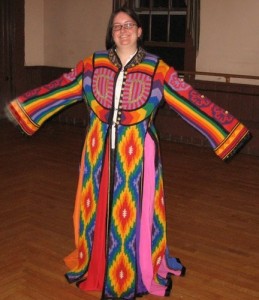 See, I’m making a blog post now because something is happening. As you can see from this ridiculous photo of me wearing an amazing technicolor dreamcoat, I’ve begun my fourth summer as PSM of The Reagle Players in Waltham, MA. Last year I did a whole fancy mini-blog about the whole season. I don’t think I’m going to be quite as detailed this year, as it would just be more of the same, but I will post my thoughts as they come.
See, I’m making a blog post now because something is happening. As you can see from this ridiculous photo of me wearing an amazing technicolor dreamcoat, I’ve begun my fourth summer as PSM of The Reagle Players in Waltham, MA. Last year I did a whole fancy mini-blog about the whole season. I don’t think I’m going to be quite as detailed this year, as it would just be more of the same, but I will post my thoughts as they come.
Some observations about our production of Joseph:
It’s a very weird show to rehearse. There are only four principals, first of all: Joseph, the Narrator, Jacob/Potiphar, and the Pharaoh. Then we have the 11 brothers and their 11 wives. Oh, and the 53 children in the choir, but that’s another story. Another thing we’ve been realizing is that the principals don’t actually do as much as you’d think. The story is structured as a narrative, and what really happens is that the chorus is really moving the story along while the principals interject their parts. It doesn’t really seem like that in the finished product, but it’s basically impossible to rehearse for very long without involving the chorus. It’s been a bit of a challenge to not have the principals sitting idle, because there’s very little they can work on while the chorus is learning something else. It doesn’t help that our principals are very quick learners, and some of them have played their roles on tour, so the little they can work on doesn’t even need much rehearsal.
Things are going really well. The whole cast is both talented and nice, which always makes me really nervous, because that never happens and I’m always wondering when the problems are going to arrive, but so far so good. Everyone seems to be having a great time. It’s a very fun show, so that may be helping as well. I’m really enjoying it because it’s one of the shows I grew up knowing every word of. Aside from Phantom, this is the first time I’ve done one of those shows that was such a part of my childhood. Some other people in the company also said that they had a similar experience with the show. We’ve decided that those of us that memorized all the colors in Joseph’s coat at the age of 12 are biologically more disposed to remember them than those who are trying to learn them now as adults.
Reagle has done the show twice before, although apparently we’re among the first (if not the first) company to do a new version of the show licensed by R&H. I hate hate hate the way the score is printed. First of all, since the show is through-sung, we didn’t get scripts, just scores. Step 1 was to make a copy reduced to 80% and stuck in the upper-left side of the page so I have room to write blocking and other notes. To make matters worse, it’s got the lyrics written so that multiple verses are written to the same bars of music (i.e. it wraps back around and you read the second line of lyrics the second time.) That’s all well and good for a lot of purposes, but I think it’s going to be a disaster to call a show that way. If the show were going to run forever the solution would be to duplicate the pages and white out the lyrics and cut and paste as needed to make it read in a linear fashion, but for 8 performances I’m trying to avoid that. I think it will depend how many cues I have in a specific section, and if I have to clean it up some other way I will. But it definitely looks like I’ll have to be following the score the whole time, which reduces the amount of time I can look up at the stage. Basically I’m in denial about the whole issue until I see what a mess it is at the paper tech. I may try to schedule the paper tech a day or two early since all the cues exist from the previous production.
One other issue we’re dealing with is that due to other events happening on our stage, we don’t get the deck until the night before tech. It happens sometimes. It happens on every Broadway show, but in our limited rehearsal time it certainly helps to have done it on stage before tech. It also makes the cast feel good to have done a run-through on stage before tech starts, so they can see the big picture before we get bogged down in the details for two days. Due to the 53 children, we’re thinking spacing may take most of our time and we may not get a run that night.
Stay tuned for more!
This is a recap of some stuff I discovered, mainly while working on Frankenstein.
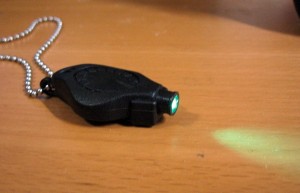 Being a stage manager, I’m naturally somewhat obsessed with flashlights, and at some point earlier in my career when searching for new toys, stumbled on the site photonlight.com. I had purchased a Photon Microlight II much earlier, at Eastern Mountain Sports or one of those places, and wore it on a chain around my neck as an all-purpose last-resort flashlight that would always be on my person. I considered it a step up from a bite light, as it had a pushbutton for momentary use, and a tiny switch so it could be left on. Thus, you could hold it in your teeth or in your hand, but without the need to actually bite on it or squeeze it to make it work. This was all well and good until I discovered the rich variety of small LED lights they sell online.
Being a stage manager, I’m naturally somewhat obsessed with flashlights, and at some point earlier in my career when searching for new toys, stumbled on the site photonlight.com. I had purchased a Photon Microlight II much earlier, at Eastern Mountain Sports or one of those places, and wore it on a chain around my neck as an all-purpose last-resort flashlight that would always be on my person. I considered it a step up from a bite light, as it had a pushbutton for momentary use, and a tiny switch so it could be left on. Thus, you could hold it in your teeth or in your hand, but without the need to actually bite on it or squeeze it to make it work. This was all well and good until I discovered the rich variety of small LED lights they sell online.
Specifically, the Photon Freedom Micro. It’s insane. It does all sorts of complicated things with only one button, I don’t even remember how to use them all.
The ones that I use:
1. Press the button, the light comes on. Press again to turn it off. Simple enough.
2. If you’re like me, and reading Howard McGillin’s crossword puzzle while stuck for 10 minutes on a bridge over the stage of the Majestic Theatre, you might not want to turn the light on to its full power, even when using a colored LED. If the light is off, simply hold down the button. This will slowly increase the brightness from nothing, and when you let go it stops at that level. So if you want only a teeny-tiny amount of light, let go as soon as it starts to light up. It’s awesome. It also works in reverse, if the light is on and you hold down the button, it dims until you let go. Once you turn it off it will return to full brightness next time you press the button.
3. It can also do crazy things like flash at different rates, or even automatically flash SOS over and over.
Next comes the ability to customize your light. For the housing there are obvious colors like black and various camo shades, but you can also get it in more funky colors. The one I use for the stage is the black covert housing, which has a little plastic hood that covers the sides of the LED, so you can only see the light when it’s pointed right at you, and the beam doesn’t spill all over the place. I have a second light with a white LED, which I keep on my keychain for general illumination, and that’s in the “fashion blue” color, just because it looks cool.
Then you get to choose the color of the LED, which offers a wide variety of choices. It should be noted that not all the colors are available with all body styles. You may have to get black or camo to get the color LED you want. The full list of colors are: white, red, orange, yellow, green, turquoise, purple, and for a few dollars more, you can even get IR or UV light. I went with turquoise for mine, because it has night vision properties, but it’s not as dark as blue, so it gives more natural illumination. I am completely opposed to using red-gelled flashlights onstage. Unless perhaps you’re doing Sweeney Todd, if the red spills anywhere that the audience can see it, it will stick out like a sore thumb, whereas shades of blue will probably blend in with your lighting better. So I’ve been really happy with the turquoise color.
Finally, you get some accessories in the box. I didn’t think much of these, since I was accustomed to using the small keychain ring on the old one to wear it on a chain around my neck. The Freedom comes with two clip accessories that the light can pop into. The first has a simple loop on it to be used on a lanyard or anywhere else you might want to tie a string through it. I still use this through the chain around my neck, but now with the advantage that I can pop it off at a moment’s notice to point it at something far away from my neck, or (gasp!) let someone else borrow it. And despite my initial fears, I have never had it pop out of the clip unexpectedly.
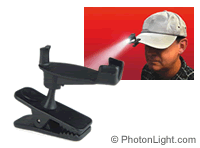 The other accessory is this amazing device that has an alligator clip with a magnetic base, so you can either clip it or magnetically attach it to something, and the light is held on a swivel so you can aim it wherever you want. As you can see the guy in the picture is wearing it on his hat. This summer I didn’t have a bedside lamp at the apartment I was staying at, so I stuck mine to the metal bedpost and used it as a reading light. But the moment that changed my life was when we started tech for Frankenstein and I attempted to clip it to my headset, on the side of the not-covered ear. I had one of the really lightweight Clearcom headsets, and the clip jiggled around on the thin metal band. I rolled a thin strip of gaff tape around the band until it was just thick enough for the clip to hold firmly, and there it remained until the show closed. Words cannot express how helpful that clip was. I was wearing way too many hats on that show, and the ability to turn on the light with one press and then be able to work handsfree was amazing. Thanks to the ability to turn the light at any angle, I could give it a quick twist and have it point exactly where I was looking, or at a different angle, so my head could be looking down at the cue light while the light was aimed up at the tape marks on the ropes I was pulling. The other cool thing was that because of the clip-in holders, at the end of the show I was able to easily pop the light out of the holder on my headset and place it back in the holder around my neck, so I didn’t have to leave it at the theatre.
The other accessory is this amazing device that has an alligator clip with a magnetic base, so you can either clip it or magnetically attach it to something, and the light is held on a swivel so you can aim it wherever you want. As you can see the guy in the picture is wearing it on his hat. This summer I didn’t have a bedside lamp at the apartment I was staying at, so I stuck mine to the metal bedpost and used it as a reading light. But the moment that changed my life was when we started tech for Frankenstein and I attempted to clip it to my headset, on the side of the not-covered ear. I had one of the really lightweight Clearcom headsets, and the clip jiggled around on the thin metal band. I rolled a thin strip of gaff tape around the band until it was just thick enough for the clip to hold firmly, and there it remained until the show closed. Words cannot express how helpful that clip was. I was wearing way too many hats on that show, and the ability to turn on the light with one press and then be able to work handsfree was amazing. Thanks to the ability to turn the light at any angle, I could give it a quick twist and have it point exactly where I was looking, or at a different angle, so my head could be looking down at the cue light while the light was aimed up at the tape marks on the ropes I was pulling. The other cool thing was that because of the clip-in holders, at the end of the show I was able to easily pop the light out of the holder on my headset and place it back in the holder around my neck, so I didn’t have to leave it at the theatre.
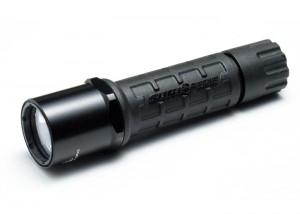 Because I’m obsessed with flashlights, I often use two during a performance — one for when a small amount of light is needed, and one for when I need a lot of light. My light of choice for the “a lot of light” category has always been the Surefire 6P. It’s reeeeeaaaalllly bright. With a Xenon bulb the battery life is pretty terrible (something like 1 hour), and the camera batteries it takes can be expensive, even when purchased in bulk. I noticed on Frankenstein that my batteries for both flashlights were running out too quickly for my tastes. I was getting less than two weeks out of the Surefire, and this distressed me, especially since I wasn’t even using it for the vast majority of my cues. I was bitching about it one night on headset, when our electrician mentioned that she had an LED Surefire, and it got much better battery life. I wasn’t even aware that Surefire had made an LED equivalent of the 6P, and I doubted it could come anywhere near the brightness of the Xenon bulb. She assured me that it was at least bright enough to see into a grid, and offered to let me play with it. A few days later I stood on the stage with my 6P and hers (which is called the G2), and shone both of them around the theatre — up to the balcony, into dark corners, etc. What I found when comparing them against a spot in the back of the balcony was that the G2 exhibits that weird murky gray-blue quality that all white LEDs have, and that the 6P was more naturally picking up the vibrant colors of the walls and doors, etc. But while the 6P was more pleasing to the eyes, the G2 was illuminating the same area well enough, and the tradeoff for better battery life seemed worth it. I ordered a G2 the next day.
Because I’m obsessed with flashlights, I often use two during a performance — one for when a small amount of light is needed, and one for when I need a lot of light. My light of choice for the “a lot of light” category has always been the Surefire 6P. It’s reeeeeaaaalllly bright. With a Xenon bulb the battery life is pretty terrible (something like 1 hour), and the camera batteries it takes can be expensive, even when purchased in bulk. I noticed on Frankenstein that my batteries for both flashlights were running out too quickly for my tastes. I was getting less than two weeks out of the Surefire, and this distressed me, especially since I wasn’t even using it for the vast majority of my cues. I was bitching about it one night on headset, when our electrician mentioned that she had an LED Surefire, and it got much better battery life. I wasn’t even aware that Surefire had made an LED equivalent of the 6P, and I doubted it could come anywhere near the brightness of the Xenon bulb. She assured me that it was at least bright enough to see into a grid, and offered to let me play with it. A few days later I stood on the stage with my 6P and hers (which is called the G2), and shone both of them around the theatre — up to the balcony, into dark corners, etc. What I found when comparing them against a spot in the back of the balcony was that the G2 exhibits that weird murky gray-blue quality that all white LEDs have, and that the 6P was more naturally picking up the vibrant colors of the walls and doors, etc. But while the 6P was more pleasing to the eyes, the G2 was illuminating the same area well enough, and the tradeoff for better battery life seemed worth it. I ordered a G2 the next day.
The other fun thing about having a Surefire is that we had a little bit of a shadow play at one point in the show, and during understudy rehearsals I would stand behind our “Creature” and hold the Surefire next to the instrument that would be illuminating him, and the beam was strong enough even under worklight to allow him, the PSM and dance captain sitting in the house to see the shadows and work on his performance of them. You can’t do that with a maglite.
I should also mention that I also have the flip-off blue filter for the Surefire. Mine is the older style, from my 6P, but I found with some elbow grease it fit on the G2 as well. Most of the time when I use the flashlight during performance, it’s with the filter on.
Batteries
Since all my batteries had been sucked up by the show, I placed a bulk battery order at the same time as I ordered the G2. When my Photon light would die, it was a tragedy. Radio shack charged something like $6 for each watch battery, of which I needed two. Twelve dollars in batteries for that tiny little light, it was almost as expensive as buying the batteries for the Surefire at retail. So I ordered a bunch of the lithium batteries for the Surefire, and also found that I could get the same watch batteries for the Photon that I bought for $6 at Radio Shack, for 51 cents!!! Needless to say I ordered a ton of them. I found the G2, and the batteries at Brightguy.com.
I hope you’ll find these products as useful as I did. I was so excited the day the order from Brightguy arrived at the theatre, I stabbed myself with my Leatherman while trying to pry off the battery door on the Photon light. I recommend the small screwdriver tip for that now, not the point of the huge freakin’ razor-sharp blade.
And finally, frequent readers will know I hate posting pictures of myself, but I feel this really requires an illustration of the headset mounting trick for the Photon light, and it so happens the only pictures of it I have include my head within the headset, so here you go:

After several weeks of unemployment, I have a little job. Actually, even Equity admits that a stage reading does not constitute “employment.” What they mean by that is, if you’re doing a show that allows you to miss rehearsal due to other employment in the industry, this is not a good enough excuse. But also, a week of work for $100 isn’t really a job. Still, I much prefer doing a reading to a showcase, as I recently turned down a 6-week showcase, even though it would have paid $600. My philosophy about jobs in theatre that don’t pay actual money is that if I’m not doing anything, I can dedicate a week of my life to meeting some new collaborators, learning a new show that might have a future, working with well-known actors I admire, and putting my full effort into making a 1-page contact sheet, putting together 29 hours of schedule, and helping them to coordinate the moving of music stands and chairs around a bare stage. I might even take the house lights up and down for the actual readings.
Contrast that to a showcase, which despite its name and original intentions, is a full production with a full design team, essentially a full-time job for usually six weeks, culminating in an actual production which needs to be loaded in, teched, and loaded out. And it still usually pays only $100 a week (if you can get it — that’s seldom the original offer). Not to mention for someone like me who subs on Broadway and Off-, I could lose far more money in lost sub work than I make doing the entire run of the Showcase. It’s happened to me several times. And lest that sound like it’s all about the money, let’s remember that if I’m taking a Showcase it means I don’t have a job. So yes, at least until the rent is accounted for, it has to be at least partially about the money. Personally I feel I’m making more art in the 8,125th running of the Phantom Overture than in many showcases I’ve done, so I actually feel no guilt about the art either.
But back to the reading. I don’t mean the title to sound like it’s going badly. It’s not at all. It’s actually something I’ve said many times, in fact to the director of this one when we first met for coffee. It really is my philosophy about doing readings. When you take a show, you don’t know if it’s going to be a good experience or a bad one, if it will go somewhere or be forgotten about forever, or if the people you meet will lead you to bigger jobs, or never call you again. In my opinion, if the show turns out to be a bad experience, there are two ways to rationalize getting out of bed in the morning: either they’re paying you a fair wage, or it will all be over soon. This is why showcases are bad — they satisfy neither criteria, so if you’re not having fun, you’re screwed.
I truly believe the process of putting eleven actors standing at music stands for 29 hours can’t possibly create the kind of unpleasantness that would make it not worth the risk. Thus, I took the job, no questions asked. We start rehearsal tomorrow, and so far I like the director, who I’ve met, I like the composer and musical director who I’ve gotten to know quite well via e-mail, and I like the cast — one of whom I’ve worked with and am thrilled to be working with again, one of whom I’ve spoken to on the phone, and the rest through e-mail. I’m excited to start meeting people and get to work.
The other great thing about this job is, as I said in an earlier post, I’ve missed being a PSM for the last six months or so. A reading doesn’t allow for the full use of PSM skills, but I’m hoping it will be enough to tide me over until summer, when I will have more responsibility than anyone could ever want, as PSM of a summer stock season.
I will share one other thing I’ve learned from being unemployed for the first time in about a year. Having a week or more to myself has reminded me how valuable my time is. I am an only child, I learned at an early age how to entertain myself. I am not bored at all. If I could be paid to do nothing forever, I would never leave my apartment. So I feel no desire to take a so-called “job” just for the sake of having one, if the money offered is not remotely worth the value of my time. I believe I provide Broadway-quality stage management to every show I do, big or small. That doesn’t mean I expect every employer to be able to pay me $1,500 a week, or anywhere near that. I know how much money I need to live, which is not much by New York standards, and I need health insurance, and I will never turn down work that meets those two requirements. But for anything below that I realize now that the only reason to take such a job would be if I wanted to. For whatever reason — believe in the show, want to work with one of the actors, like the director, trying to get in with the producer. There has to be a reason I want it, so badly that I’d rather do the show than sit comfortably at home doing something else. And in the last month I’ve learned that there’s nothing wrong with saying no to working your ass off when there’s little or nothing to be gained. In no other industry would anyone be made to feel guilty over such a decision. Should I call up an accountant and ask him to do my taxes for $5 in his spare time at night? If he tells me he’s actually quite busy watching American Idol, do I have a right to question his devotion to developing his accounting skills?
Now that I’m spending some time back at the bottom of the industry, just wanted to share the view. It’s easy to forget when you get used to a weekly paycheck.
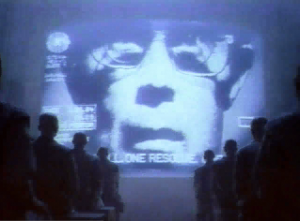 But in that way that you can’t even worry about your privacy because it’s just so damn cool.
But in that way that you can’t even worry about your privacy because it’s just so damn cool.
Hey, two posts in one day! I have to tell you what just happened to me.
I’m doing this reading next week, so I’m in preproduction. I have some contact info for the cast and creative team, so I’m starting to enter it into Apple’s Address Book app. I’m using the cool new feature that Mail has in Leopard where it detects phone numbers and e-mail addresses in your mail and offers to add them to your address book. Since the only contact info I have is in plain text in an e-mail from the director, this saves me a lot of retyping or cutting and pasting. The system is not perfect by any means, but it’s still a time saver.
So I get to this one actor, who is a Broadway actor that I’ve vaguely heard of, but one I’m sure I’ve never met. I create a contact in my address book based on his e-mail address, and when I later go back to sort my contacts, I find that the guy’s headshot has been added in the photo slot of his contact file! I then see that his e-mail is from a dot Mac account, which no doubt somehow explains this. I’m not sure if this is a feature you have to opt in for, but what I’m guessing is happening is that Address Book automatically matches @mac.com e-mail addresses to the person’s account and their own address card. It hasn’t filled in any other personal information though, as I’m still lacking his phone number (this is definitely a good thing, for privacy reasons). Maybe it just does the picture. I will post an update if I find out more about how this is done.
UPDATE: Found out how it’s done. A quick search on MacNN solves all.
If you have a .Mac account you can go to the webmail page (webmail.mac.com) and click on preferences (upper right of your mailbox area). In the “Composing” tab, there is a place where you can add your photo. Presumably from there all Mac users will see this photo when they read your e-mails in Mail or they enter your e-mail address in their Address Book. I didn’t have a photo set, but obviously I need to add one now. Will it look unprofessional if I use my default iChat icon?
